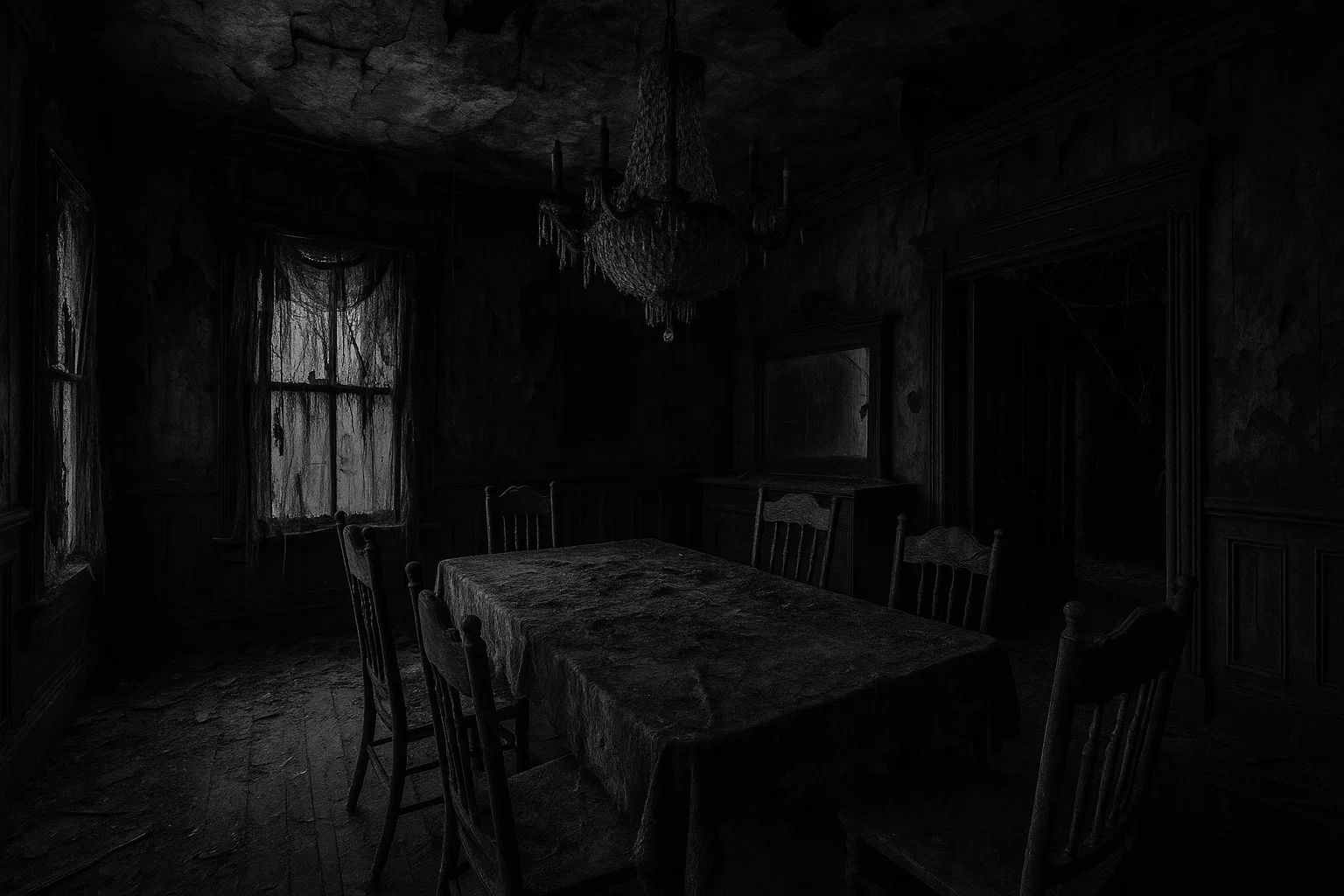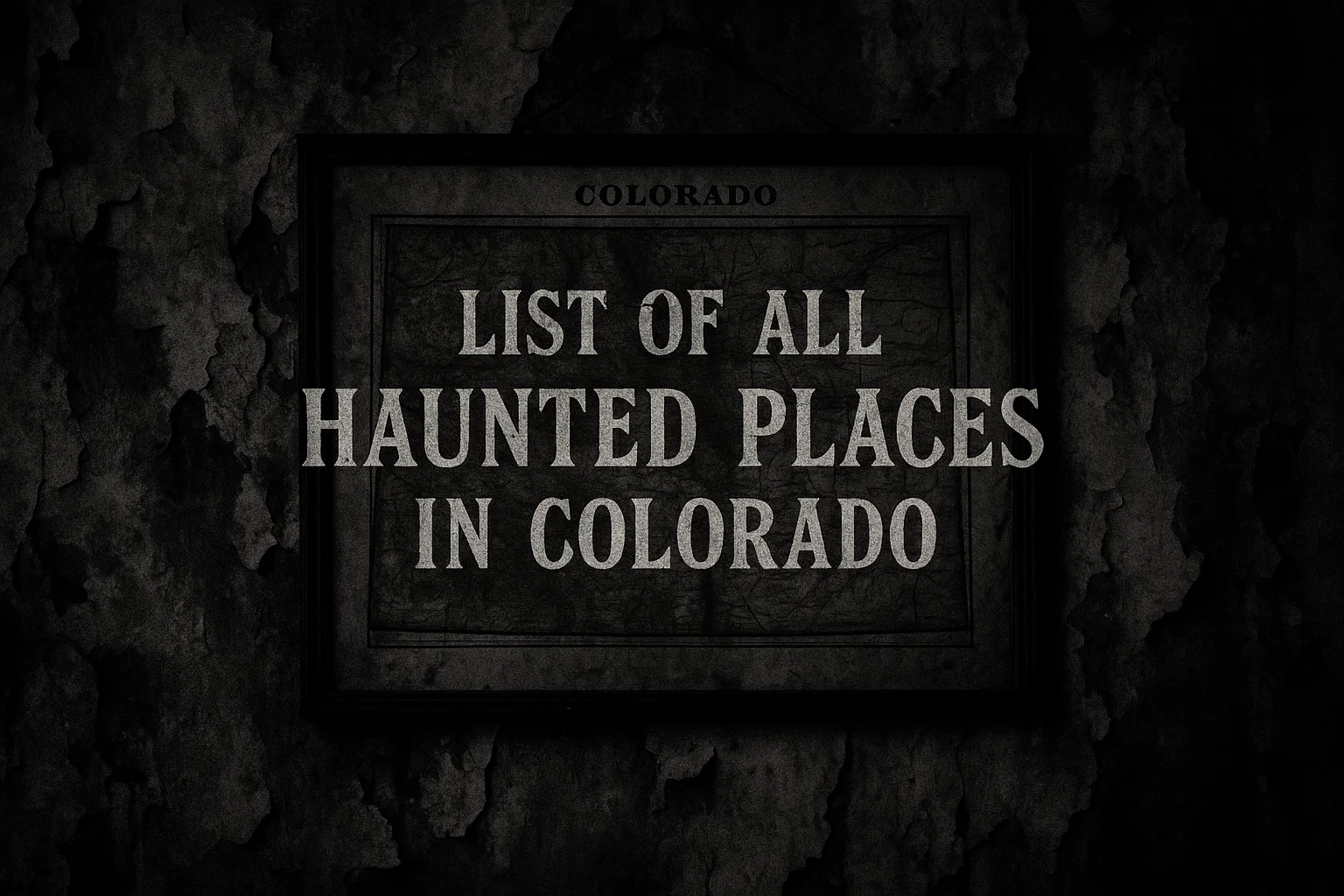Arkansas is home to many historic residences with strange and creepy true stories. These haunted houses in Arkansas, echoes of untimely deaths and unresolved sorrows, are said to linger in the shadowed halls and empty rooms.
Common threads include suicides born of forbidden love, fatalities from industrial accidents and wartime wounds, strokes felling ambitious builders, and the quiet passing of children amid familial prosperity.
Such events have imbued these structures with an aura of unrest, attracting both paranormal investigators and curious visitors.
Reports of apparitions, unexplained sounds, and poltergeist activity suggest that the boundaries between past grief and present unease remain permeable, transforming these places into some of the most haunted houses in Arkansas.
Summary
Allen House, Monticello
The Allen House, constructed in 1906 in Monticello, Drew County, Arkansas, stands as a prominent example of Queen Anne Victorian architecture, characterized by its neoclassical porch columns, Gothic decorative elements, and imposing facade along North Main Street.
Built by local businessman Joe Lee “Jolie” Allen as a family residence for his wife, Caddye Allen, and their three daughters—Lonnie Leigh, Ladell, and Loui—the home symbolized prosperity amid the region’s lumber and mercantile booms.
Allen’s ventures in hotels, loans, and automobiles flourished until his sudden death on October 23, 1917, when he was fatally struck by a vehicle while demonstrating a new model to a prospective buyer. His body was returned to the house for a funeral in the parlor two days later, marking the first major tragedy to shadow the property.
However, the most profound sorrow unfolded decades later, intertwining personal despair with whispers of haunting.
Ladell Allen Bonner (the middle daughter born in 1894) endured a tumultuous life marked by an unhappy marriage to Boyd Bonner in 1914, which ended in divorce by 1927. Their union produced a son, Allen Bonner, but further grief struck when the young man succumbed to pneumonia in 1944 at age 28.
Ladell’s existence grew increasingly isolated; by the late 1940s, she lived alone in the family home after her sisters and mother had passed away.
On Christmas night 1948, during her mother’s annual holiday gathering, Ladell ingested mercury cyanide in the master bedroom, an act ruled a suicide. She lingered in agony for twelve days before dying on January 5, 1949, at age 54.
Contemporary newspaper accounts portrayed her as a beloved local figure. However, later discoveries revealed a cache of love letters hidden beneath the attic floorboards, chronicling a decades-long affair with her high school sweetheart, Prentiss Savage.
The correspondence, uncovered by subsequent owners Mark and Rebecca Spencer in the early 2000s, suggested that Savage’s abrupt termination of the relationship precipitated her despair.
These layered tragedies—familial loss, accidental death, and romantic betrayal—have been invoked to explain the Allen House’s reputed hauntings.
The Spencers, who purchased the dilapidated structure in 1998 and restored it while documenting phenomena in the 2012 book A Haunted Love Story: The Ghosts of the Allen House, reported apparitions of Ladell in the sealed-off bedroom window, cold spots, and electronic voice phenomena captured by investigators.
Over twelve paranormal groups, including those featured on television programs, have documented footsteps, shadowy figures, and objects moving unaided.
The house’s division into apartments after the Allen family’s demise in the mid-20th century, followed by its revival as a private residence, has not quelled the unrest. Instead, it highlights a narrative of unresolved anguish that persists amid architectural splendor.
Today, although closed to public tours since 2024, the Allen House’s tumultuous history makes it one of the most haunted houses in Arkansas.
You May Also Like: The 9 Most Haunted Hotels in Arkansas You Can Still Visit
Clayton House, Fort Smith
Another great example of an allegedly haunted house in Arkansas is the infamous Clayton House. The property, located at 514 North 6th Street in Fort Smith’s Belle Grove Historic District, exemplifies Italianate Victorian design with its two-and-a-half-story L-shaped frame, clipped-gable facade, elaborate trim, and expansive porches.
Built around 1852 as a modest clapboard closeby an unknown early settler, the structure underwent significant expansion in 1882 under the ownership of William Henry Harrison Clayton, a Pennsylvania-born Union veteran appointed U.S. Attorney for the Western District of Arkansas by President Ulysses S. Grant in 1874.
Clayton, who collaborated with the infamous “Hanging Judge” Isaac Parker to curb frontier lawlessness, transformed the home into a stately mansion, adding a drawing room, study, office, and grand walnut staircase to accommodate his wife, Florence Williams Clayton, and their children.
Why Do So Many Successful People Secretly Wear a Little Blue Eye?
Limited time offer: 28% OFF. For thousands of years, the Turkish Evil Eye has quietly guarded wearers from the unseen effects of jealousy and malice. This authentic blue glass amulet on a soft leather cord is the real thing – beautiful, powerful, and ready for you.
Tragedy permeated the site’s history long before Clayton’s tenure, rooted in its role during the American Civil War. Abandoned by its original owner—who fled to Texas amid escalating conflict—the house served as a Union military hospital, where surgeons performed gruesome amputations on soldiers ravaged by battlefield injuries.
Accounts describe rooms stained with blood, filled with the cries of the wounded, and the inevitability of death for many under primitive medical conditions. This era of suffering, when Fort Smith functioned as a volatile border outpost between Arkansas and Indian Territory, left an indelible scar, with residual energies purportedly manifesting as echoes of wartime agony.
Clayton’s own narrative added layers of loss and transience. Despite his prominence—having prosecuted over 150 cases in Parker’s court—the family relocated in 1897 when Clayton was appointed a federal judge for the Central District of Indian Territory, necessitating a move to McAlester.
The house then devolved into a boarding facility from 1900 onward, housing transient residents amid Fort Smith’s post-Reconstruction economic flux.
By the mid-20th century, neglect threatened demolition; in 1969, preservationist Julia Yadon intervened, forming the nonprofit Fort Smith Heritage Foundation to orchestrate a seven-year restoration, which culminated in its reopening as a museum in 1977. Yadon’s portrait now graces the premises, a testament to her role in salvaging the structure from oblivion.
These cumulative traumas—wartime fatalities, familial upheaval, and institutional decay—underpin the Clayton House’s reputation as one of the most haunted houses in Arkansas.
Staff and visitors report apparitions, including a spectral woman in Clayton’s study captured in 2007-2008 repair photographs, and a “Tall Angry Man” mistaken for a reenactor.
The Paranormal Investigation and Research of Western Arkansas has conducted multiple investigations, yielding electronic voice phenomena (EVPs) that include footsteps, whispers, and the sound of slamming doors. Cold spots, phantom music from empty parlors, and inexplicable shifts in objects evoke the hospital’s lingering despair.
As a National Register of Historic Places listing since 1970, the Clayton House not only chronicles Fort Smith’s Victorian elegance but also its underbelly of violence and impermanence, where historical wounds manifest as contemporary chills.
You May Also Like: 9 Haunted Houses in Arizona That Hold Terrifying Secrets
Empress of Little Rock (Hornibrook Mansion), Little Rock
The Empress of Little Rock, originally the Hornibrook Mansion, is located at 501 East 9th Street in Little Rock’s Quapaw Quarter, embodying Gothic-Queen-Anne-Victorian opulence with its two-story brick construction, wraparound porch, divided grand staircase, and tower room.
Built in 1888 by the Canadian immigrant and saloon magnate James H. Hornibrook, the residence rivaled the nearby Villa Marré—home of competitor Angelo Marré—in extravagance, featuring ornate interiors funded by a prosperous liquor partnership with Miles Q. Townsend that thrived for over two decades following the Civil War.
Hornibrook, who relocated from Toronto in 1867 with his wife, Margaret R. McCulley Hornibrook, and their children, chose the site’s southern outskirts to avoid the societal scrutiny of Scott Street’s trade, and he incorporated a tower to surveil potential raids on his establishments.
However, the Hornibrooks’ tenure was marred by swift and profound loss. Their son, Matt, perished in childhood shortly after the family arrived in Arkansas, a blow that shadowed the household’s early years.
Construction delays plagued the project, but completion brought no respite. In 1890, mere two years after occupancy, James Hornibrook collapsed at the front gate from an apoplectic stroke—likely a cerebral hemorrhage—and died at age 50.
His premonition of early death prompted a macabre precaution: a plaster death mask crafted years prior, now displayed in the inn. Margaret, left to manage the estate amid financial strains from the Panic of 1893, sold the property in 1896.
It was repurposed as Arkansas Women’s College from 1897 until the Great Depression, then remained vacant until it was converted into a nursing home in 1948. This was followed by the development of private residences and apartments throughout the mid-20th century.
This sequence of bereavement—infant mortality, sudden paternal demise, and economic ruin—forces a narrative of interrupted legacy, amplified by the building’s institutional phases where isolation and decline fostered further unnamed sorrows.
Ever Walk Into a Room and Instantly Feel Something Watching You?
Millions have used burning sage to force out unwanted energies and ghosts. This concentrated White Sage & Palo Santo spray does the same job in seconds – just a few spritzes instantly lifts stagnation, breaks attachments, and restores peace most people feel immediately.
Acquired in 1993 by Sharon Welch-Blair and Robert Blair, the structure underwent meticulous restoration to its original floor plan and reopened in 1995 as a bed and breakfast. Yet renovations unearthed unrest: a worker spotted a Homburg-hatted man in the attic, presumed to be Hornibrook himself.
Hauntings are attributed to these foundational griefs, with guests and staff encountering a well-dressed male apparition—possibly James—alongside a woman in pink, a chambermaid, and a figure resembling a sea captain.
Footsteps traverse vacant hallways, voices murmur from unoccupied suites, and furniture drags across upper floors unbidden. Fireplaces ignite spontaneously in the original master suite, while cold spots and chills pervade, particularly during the Blairs’ early efforts.
The National Register of Historic Places lauds it as Arkansas’s finest ornate Victorian exemplar, but its spectral vitality—deemed non-malevolent—transforms this place into one of the most haunted houses in Arkansas.
You May Also Like: 11 Haunted Hotels in Arizona—and the Real Tragedies Behind Them
Johnson-Sanderson Mansion, Jonesboro
The Johnson-Sanderson Mansion, situated in Jonesboro, Craighead County, Arkansas, exemplifies late 19th-century residential architecture with its multi-story frame and period interiors. However, specific stylistic details remain less documented than their social lineage.
Constructed in the 1880s, the home initially served as the residence for the Johnson family, prominent local retailers whose mercantile success amid post-Reconstruction growth elevated their status in the burgeoning railroad hub.
By the early 20th century, ownership had transferred to the Sanderson family, whose patriarch had held a mayoral office, thereby embedding the property in civic narratives of progress and governance.
Over the decades, it served as a private residence, housing Arkansas State University students as renters, and briefly as a tea room, reflecting Jonesboro’s evolution from an agrarian outpost to an educational center.
Tragedies within its walls are inferred from the era’s harsh realities rather than singular cataclysmic events, fostering a cumulative pall of sorrow.
The Johnsons navigated the economic volatility of the 1880s and 1890s, including crop failures and market fluctuations that strained even affluent households, potentially contributing to unrecorded familial stress or loss.
The Sandersons, during their tenure, contended with the social upheavals of the Progressive Era, including labor disputes tied to Jonesboro’s rail and timber industries, where workplace fatalities were commonplace.
Local lore, preserved in Edward L. Underwood’s Haunted Jonesboro (2012), hints at interpersonal discord. One account describes a young girl—possibly a daughter or relative—who was struck forcefully by an invisible entity during a familial argument, requiring hospitalization and amplifying perceptions of malevolent unrest.
Such incidents evoke the domestic tensions of Victorian-era child-rearing, where corporal discipline intersected with emerging psychological awareness, leaving psychic imprints of conflict and vulnerability.
These undercurrents of hardship and hidden violence underpin the mansion’s haunted designation, with manifestations centered on poltergeist-like disturbances.
A hooded figure has been observed gliding across rooms, rearranging furniture—such as shifting a wardrobe at midnight—before vanishing. Doors swing open and shut autonomously, while a music harp resonates without touch, its melancholic strains echoing unresolved grievances.
Upstairs closets, once play spaces for local children, harbor cold spots and whispers, suggesting juvenile spirits tethered to sites of youthful indiscretion or peril.
As a private property not open to formal tours, the Johnson-Sanderson Mansion endures in oral traditions, its history a microcosm of Jonesboro’s ascent, shadowed by the quiet tolls of prosperity—lost opportunities, silenced arguments, and the fragility of family amid industrial fervor.
You May Also Like: The Japanese Oni Monster: Appearance, Powers, and Myths
Peel Mansion, Bentonville
The Peel Mansion, situated at 400 South Walton Boulevard in Bentonville, Benton County, Arkansas, exemplifies the pinnacle of Italianate villa architecture. The building is characterized by its two-story stuccoed brick form, central three-story hip-roofed tower, and expansive grounds that once encompassed 180 acres of apple orchards.
Commissioned in 1875 by Colonel Samuel West Peel, a Mexican-American War veteran who ascended to Confederate colonel during the Civil War, the fourteen-room estate fulfilled a promise to his wife, Mary Emaline Berry Peel, evoking her Alabama girlhood amid their post-war relocation from Carrollton.
Peel, admitted to the bar in 1865, served as prosecuting attorney for Arkansas’s Fourth Judicial Circuit (1873-1876) and later as U.S. Representative (1885-1893), co-founding the First National Bank of Bentonville and amassing wealth through law and agriculture.
The Peels’ prosperity masked profound familial devastation, which began with the toll of the Civil War. Samuel’s military service separated him from Mary and their children, exposing the household to foraging raids and scarcity. Post-war, Arkansas’s Reconstruction-era strife exacerbated its vulnerabilities.
Tragedy compounded through the untimely deaths of multiple offspring: daughters Zillah and another perished young, while sons James McFerrin (prosecuting attorney), David Walker (bank president), and Frank West (University of Virginia alumnus) outlived siblings but navigated lives shadowed by parental loss. Mary, a Berry family scion—sister to Governor James H. Berry—preserved foodstuffs post-war to avert famine, her resilience a bulwark against grief.
Samuel’s 1907 death at 83 marked the end of an era, leaving the mansion to descendants who sold it in 1926.
Subsequent custodians amplified the site’s sorrowful legacy. The English family, which acquired it in the 1920s for an apple venture, applied stucco to the exterior.
Later, as a fraternity house, junior high, and public library through the mid-20th century, it hosted generations amid institutional flux. A pivotal haunt-origin tale involves an unnamed girl’s fatal surgery in an upstairs room during this period, after which the space was locked for forty years, its occupant convinced of spectral crying within—later identified by a past-life claimant as her own demise.
These cascades of bereavement—wartime privation, child mortality, and adaptive repurposing—fuel the Peel Mansion’s hauntings, now a museum since 1992 under the Peel Compton Foundation.
Today, visitors report hearing disembodied footsteps, voices, and self-moving objects; piano melodies emanate from empty parlors, attributed to the ghost of Minnie Belle Peel, the daughter.
Colonel Peel’s apparition pinches guests, while a woman in white—evoking lost daughters—manifests in the tower. As a National Register site since 1995, this haunted house in Arkansas blends horticultural gardens with spectral intrigue, its history a chronicle of ambition tempered by inexorable loss.
You May Also Like: Penpal: A Haunting Short Horror Story
Rush-Gates House (St. Francis County Museum), Forrest City
The Rush-Gates House, located at 603 Front Street in Forrest City, St. Francis County, Arkansas, is a two-story frame residence built in 1906, blending practical functionality with early 20th-century domesticity as both a home and a medical office.
Constructed by Dr. James Oliver Rush, a Missouri native who relocated to the area in 1900 as a surgeon for the Iron Mountain Railroad, the structure’s proximity to the tracks facilitated emergency care for industrial accidents prevalent in the timber and rail industries.
Rush, a multifaceted figure as a physician, local historian, and amateur archaeologist, amassed over 3,700 Native American artifacts and prehistoric relics starting in 1912, including mastodon fossils from Crowley’s Ridge, which formed the nucleus of the site’s future collections.
Tragedy defined Rush’s practice and legacy, transforming the house into a locus of suffering.
As Forrest City’s primary medical facility before a dedicated hospital, the downstairs surgery room hosted countless procedures under rudimentary conditions: railroad workers arrived with mangled limbs from derailments, loggers with infections from sawmill mishaps, and civilians with untreated ailments.
Many patients succumbed on-site, their final moments echoing through the building amid ether anesthesia and unsterilized tools. Rush’s own life was intertwined with these losses.
At the same time, specifics of personal bereavement are sparse; his vocation exposed him to communal grief, including the 1918 influenza pandemic’s toll on St. Francis County.
Following his death—date unchronicled but post-1930s—the property remained in family hands until 1995, when it was deeded to the county. Renovations in 1997-1998 established the St. Francis County Museum, enshrining Rush’s artifacts alongside exhibits on geology, veterans, African American history, and local pioneers.
This heritage of mortality—anonymous deaths in a pre-modern medical frontier—underlies the Rush-Gates House’s haunted status, ranked among Arkansas’s top ten by the Arkansas Paranormal and Anomalous Studies Team (ARPAST).
Post-renovation anomalies include shadows and silhouettes visible in windows after hours, even when no occupants are present. Doors unlatched swing open independently, while muttering voices and footsteps traverse vacant corridors, evoking spectral consultations. Objects vanish and reappear, such as utensils relocating inexplicably in the kitchen, mirroring the disarray of hurried surgeries.
The museum’s annual “A Night at the Museum” ghost tours, offered in conjunction with local hotels, amplify these phenomena, blending education with encounters.
As a nonprofit organization preserving Eastern Arkansas’s narrative since 1997, the site transcends its morbid origins; yet, the persistent unrest suggests that Rush’s healing haven endures as a threshold where the quick and the dead converge, bound by the era’s unforgiving exigencies.









